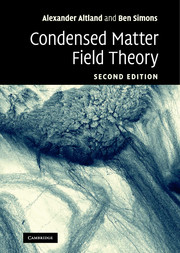Book contents
- Frontmatter
- Contents
- Preface
- 1 From particles to fields
- 2 Second quantization
- 3 Feynman path integral
- 4 Functional field integral
- 5 Perturbation theory
- 6 Broken symmetry and collective phenomena
- 7 Response functions
- 8 The renormalization group
- 9 Topology
- 10 Nonequilibrium (classical)
- 11 Nonequilibrium (quantum)
- Index
4 - Functional field integral
Published online by Cambridge University Press: 04 August 2010
- Frontmatter
- Contents
- Preface
- 1 From particles to fields
- 2 Second quantization
- 3 Feynman path integral
- 4 Functional field integral
- 5 Perturbation theory
- 6 Broken symmetry and collective phenomena
- 7 Response functions
- 8 The renormalization group
- 9 Topology
- 10 Nonequilibrium (classical)
- 11 Nonequilibrium (quantum)
- Index
Summary
In this chapter, the concept of path integration is generalized to integration over quantum fields. Specifically we will develop an approach to quantum field theory that takes as its starting point an integration over all configurations of a given field, weighted by an appropriate action. To emphasize the importance of the formulation that, methodologically, represents the backbone of the remainder of the text, we have pruned the discussion to focus only on the essential elements. This being so, conceptual aspects stand in the foreground and the discussion of applications is postponed to the following chapters.
In this chapter, the concept of path integration is extended from quantum mechanics to quantum field theory. Our starting point is a situation very much analogous to that outlined at the beginning of the previous chapter. Just as there are two different approaches to quantum mechanics, quantum field theory can also be formulated in two different ways: the formalism of canonically quantized field operators, and functional integration. As to the former, although much of the technology needed to efficiently implement this framework – essentially Feynman diagrams – originated in high-energy physics, it was with the development of condensed matter physics through the 1950s, 1960s, and 1970s that this approach was driven to unprecedented sophistication. The reason is that, almost as a rule, problems in condensed matter investigated at that time necessitated perturbative summations to infinite order in the non-trivial content of the theory (typically interactions).
- Type
- Chapter
- Information
- Condensed Matter Field Theory , pp. 156 - 192Publisher: Cambridge University PressPrint publication year: 2010

